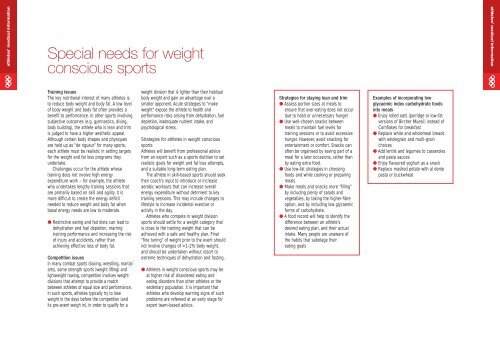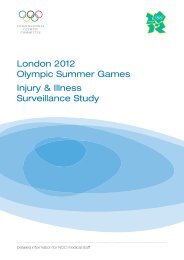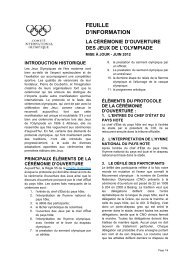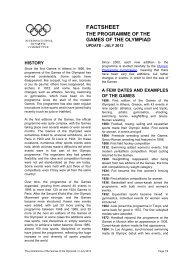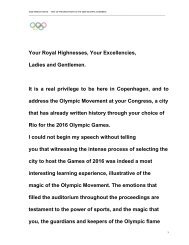IOC NUTRITION INSIDE PAGES 2
IOC NUTRITION INSIDE PAGES 2
IOC NUTRITION INSIDE PAGES 2
You also want an ePaper? Increase the reach of your titles
YUMPU automatically turns print PDFs into web optimized ePapers that Google loves.
athletes’ medical information<br />
Special needs for weight<br />
conscious sports<br />
Training issues<br />
The key nutritional interest of many athletes is<br />
to reduce body weight and body fat. A low level<br />
of body weight and body fat often provides a<br />
benefit to performance. In other sports involving<br />
subjective outcomes (e.g. gymnastics, diving,<br />
body building), the athlete who is lean and trim<br />
is judged to have a higher aesthetic appeal.<br />
Although certain body shapes and physiques<br />
are held up as “de rigueur” for many sports,<br />
each athlete must be realistic in setting targets<br />
for the weight and fat loss programs they<br />
undertake.<br />
Challenges occur for the athlete whose<br />
training does not involve high energy<br />
expenditure work – for example, the athlete<br />
who undertakes lengthy training sessions that<br />
are primarily based on skill and agility. It is<br />
more difficult to create the energy deficit<br />
needed to reduce weight and body fat when<br />
basal energy needs are low to moderate.<br />
● Restrictive eating and fad diets can lead to<br />
dehydration and fuel depletion, marring<br />
training performance and increasing the risk<br />
of injury and accidents, rather than<br />
achieving effective loss of body fat.<br />
Competition issues<br />
In many combat sports (boxing, wrestling, martial<br />
arts), some strength sports (weight lifting) and<br />
lightweight rowing, competition involves weight<br />
divisions that attempt to provide a match<br />
between athletes of equal size and performance.<br />
In such sports, athletes typically try to lose<br />
weight in the days before the competition (and<br />
its pre-event weigh in), in order to qualify for a<br />
weight division that is lighter than their habitual<br />
body weight and gain an advantage over a<br />
smaller opponent. Acute strategies to “make<br />
weight” expose the athlete to health and<br />
performance risks arising from dehydration, fuel<br />
depletion, inadequate nutrient intake, and<br />
psychological stress.<br />
Strategies for athletes in weight conscious<br />
sports<br />
Athletes will benefit from professional advice<br />
from an expert such as a sports dietitian to set<br />
realistic goals for weight and fat loss attempts,<br />
and a suitable long-term eating plan.<br />
The athlete in skill-based sports should seek<br />
their coach’s input to introduce or increase<br />
aerobic workouts that can increase overall<br />
energy expenditure without detriment to key<br />
training sessions. This may include changes to<br />
lifestyle to increase incidental exercise or<br />
activity in the day.<br />
Athletes who compete in weight division<br />
sports should settle for a weight category that<br />
is close to the training weight that can be<br />
achieved with a safe and healthy plan. Final<br />
“fine tuning” of weight prior to the event should<br />
not involve changes of >1-2% body weight,<br />
and should be undertaken without resort to<br />
extreme techniques of dehydration and fasting.<br />
● Athletes in weight conscious sports may be<br />
at higher risk of disordered eating and<br />
eating disorders than other athletes or the<br />
sedentary population. It is important that<br />
athletes who develop warning signs of such<br />
problems are refereed at an early stage for<br />
expert team-based advice.<br />
Strategies for staying lean and trim<br />
● Assess portion sizes at meals to<br />
ensure that over-eating does not occur<br />
due to habit or unnecessary hunger<br />
● Use well-chosen snacks between<br />
meals to maintain fuel levels for<br />
training sessions or to avoid excessive<br />
hunger. However, avoid snacking for<br />
entertainment or comfort. Snacks can<br />
often be organised by saving part of a<br />
meal for a later occasions, rather than<br />
by eating extra food.<br />
● Use low-fat strategies in choosing<br />
foods and while cooking or preparing<br />
meals<br />
● Make meals and snacks more “filling”<br />
by including plenty of salads and<br />
vegetables, by taking the higher-fibre<br />
option, and by including low glycaemic<br />
forms of carbohydrate.<br />
● A food record will help to identify the<br />
difference between an athlete’s<br />
desired eating plan, and their actual<br />
intake. Many people are unaware of<br />
the habits that sabotage their<br />
eating goals<br />
Examples of incorporating low<br />
glycaemic index carbohydrate foods<br />
into meals<br />
● Enjoy rolled oats (porridge or low-fat<br />
versions of Bircher Muesli) instead of<br />
Cornflakes for breakfast<br />
● Replace white and wholemeal breads<br />
with wholegrain and multi-grain<br />
choices<br />
● Add lentils and legumes to casseroles<br />
and pasta sauces<br />
● Enjoy flavoured yoghurt as a snack<br />
● Replace mashed potato with al dente<br />
pasta or buckwheat<br />
athletes’ medical information


